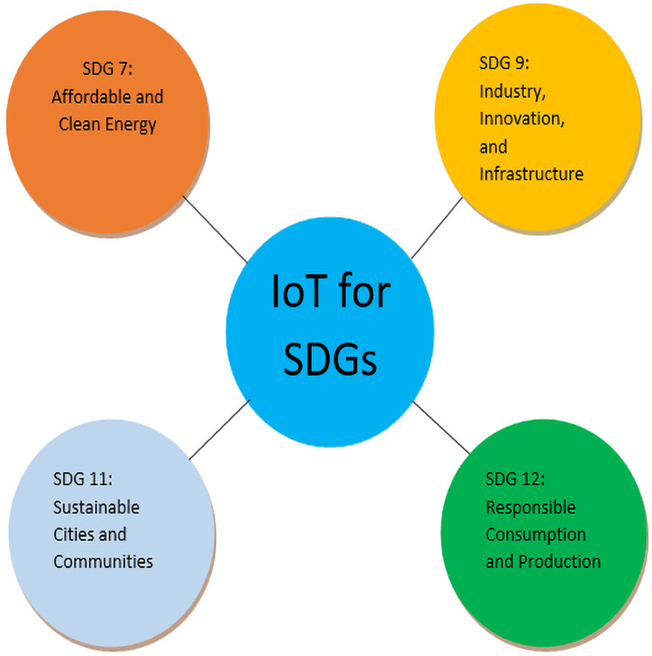IoT sustainability – Looking Ahead into the Future of IoT
By Patrice Duren / March 22, 2024 / No Comments / AWS Certification Exam, Working with partners on IIoT
Sustainability is a big goal that many companies and individuals are moving toward. In this section, we will explore guidelines for being able to achieve better United Nations sustainability goals and understand how to better IoT sustainability.
Aligning IoT practices with sustainable development goals
Architecting for IoT sustainability involves designing IoT systems with a holistic approach that considers the environmental, social, and economic impacts of IoT devices. This aligns with several of the United Nations’ sustainable development goals (SDGs):

Figure 15.1 – IoT for SDGs
These goals include the following:
SDG 7: Ensure access to affordable, reliable, sustainable, and modern energy for all. To align with this goal, IoT systems should be designed to reduce energy consumption by using low-power communication protocols and energy-efficient hardware.
SDG 9: Build resilient infrastructure, promote sustainable industrialization, and foster innovation. To align with this goal, IoT systems should be designed to promote sustainable industrialization by using recyclable materials and designing devices that can be easily disassembled and recycled.
SDG 11: Make cities and human settlements inclusive, safe, resilient, and sustainable. To align with this goal, IoT systems should be designed to promote sustainable urbanization by reducing energy consumption and designing for EOL considerations.
SDG 12: Ensure sustainable consumption and production patterns. To align with this goal, IoT systems should be designed to promote sustainable consumption by designing devices with EOL considerations in mind and by implementing circular economy models around IoT devices.
With the preceding list, we have obtained a better understanding of the SDGs relevant to IoT. Now, we can take a look at what we can do for further IoT sustainability.
What to do for IoT sustainability?
IoT sustainability is a growing concern as the number of connected devices continues to increase. As we integrate more devices into our lives and businesses, we need to ensure that we’re doing so in a way that is environmentally responsible and sustainable.
One of the main ways to promote IoT sustainability is by reducing the energy consumption of IoT devices. This can be achieved using low-power communication protocols and energy-efficient hardware. For example, using protocols such as LoRaWAN and NB-IoT, LTE-M, BLE, BLE-LR, and Wi-Fi HaLow can significantly reduce the power consumption of IoT devices compared to traditional Wi-Fi and cellular networks.
Another way to promote IoT sustainability is by designing devices with EOL considerations in mind. This includes using recyclable materials and designing devices that can be easily disassembled and recycled. This not only reduces the environmental impact of IoT devices but can also create new opportunities for businesses to develop circular economies around IoT devices.
New wireless technologies, coupled with the development of low-cost IoT chipsets, are significantly making an impact as well. These advancements are enabling a vast expansion in the deployment of IoT devices, as lower costs and improved wireless capabilities make them more accessible and versatile. This proliferation is particularly beneficial for environmental monitoring, energy management, and resource conservation. For instance, IoT devices can now more effectively monitor environmental conditions, optimize energy use in smart buildings, and streamline waste management, all of which contribute to reduced carbon footprints and enhanced resource efficiency. The integration of these technologies is not only making IoT devices more affordable and efficient but also driving innovation toward a more sustainable and technologically advanced society.
In addition to reducing energy consumption and designing for EOL considerations, IoT sustainability also involves addressing issues such as data privacy and security. As IoT devices collect and transmit sensitive data, it’s important to implement strong security measures to protect that data from being compromised. This includes using encryption, implementing secure communication protocols, and regularly updating device firmware to address any known vulnerabilities.
To effectively promote IoT sustainability, it’s essential to adopt a comprehensive approach that considers the environmental, social, and economic effects of IoT devices. By considering the entire life cycle of IoT devices and designing for sustainability, we can ensure that IoT continues to benefit society while minimizing its impact on the environment.
With that, we have taken a good look at what sustainability means for IoT, including how it stands with SDGs. We can now take a look at our final practical for the book: creating an IoT-integrated Amazon Bedrock Retrieval Augmented Generation (RAG) web application.